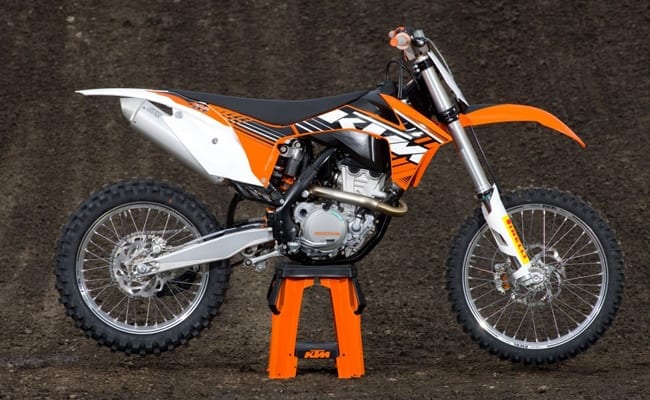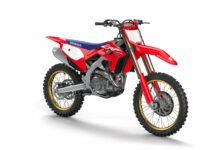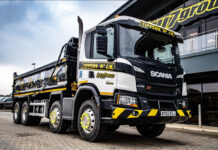High above northern Europe, feeling like I’d been wrestling Dawn French, I mused upon how early in the year it was to be testing 2012 bikes. Of course, I hadn’t actually been wrestling Frenchy – I was just in agony from my first competitive MX race in over three years just three days earlier.
After finally accepting that the hot stewardess wasn’t ever going to be besotted with a shattered-looking bald man I sat there with my tomato juice, pondering how on the ball KTM really have been over the past decade. I was on my way to Munich in May to test six 2012 machines in their SX range. Chuck in KTM’s kiddie bikes, their huge fleet of enduro/XC machines not to mention road burners, cars and toasters and you can’t help feeling a sense of awe at how they’ve stepped it up to take on the Japanese Big Four.
Right, let’s get down to business on these bikes – we’ll start small and work our way up…
125 SX
Brilliant! Right, now onto the 150! Seriously, this was my bike of the day and you can pretty much sum it up with that one word. The KTM 125 has been famous for its strong motor for years and somehow they’ve managed to get even more out of it this time around. It’s faster and has more torque right across the range. The only improvement performance wise for 2012 is a new air intake boot – and what an improvement it is! This thing rips and I absolutely loved riding it.
Personally I feel it should be compulsory that young riders coming up through the ranks should ride a 125. I think it would help the sport and it might actually encourage some of the other manufacturers to start making them again. I live in hope.
150 SX
For 30-somethings intent on ignoring the onset of middle-aged spread and kidding themselves they’re still in their late teens this bike is awesome! It may only have an extra 25 cubes on the 125 but they make a difference, even though the 125 seems much closer to the 150 in power output this year. The thing with the 150 is you get the same buzz as with the 125 but don’t have to be so precise with the gear changes and can be just that little bit fatter/older/lazier.
On certain corners you can hold onto a gear a little longer than on the 125 and don’t have to change down to get the most out of the engine beneath you. The same could be said of the 2011 model but like the new 125 they’ve also improved this power delivery so both bikes have gotten even more grunt and are easier to ride.
The 150 has the new intake boot too but they’ve also stuck a new exhaust pipe on so now it really sings in the mid-range and up onto the top without any compromise to the power delivery at the bottom. There’s also a new, lighter kickstarter on the 125 and 150 to make starting even easier (as if they weren’t easy enough).
250 SX
In all honesty I’ve felt since the 150 was introduced the KTM family dynamics changed and it seemed to steal the 250’s thunder. All the attention quite rightly went to it and the 250 SX no longer fitted in. Well, it’s like the 250’s gone away, got itself a new attitude and look and made everyone proud. This is another great bike. Gone is that harsher ride compared to its rivals and now it’s a much better handling and easier to ride motorcycle with a more balanced torque to the motor.
The 250 also gets a chassis make over. The obvious change being that the entire adult two-stroke MX range now has a rear suspension linkage. The PDS has finally been put aside for that slightly better feel that a linkage brings. Okay, so that’s my opinion – others may differ but considering KTM have now made that change it suggests they agree with me and many others.
To account for the new linkage the geometry of the frame has changed but there’s still no sign of an aluminium frame on the KTM’s and I don’t expect to see one anytime soon to be honest because clearly the double cradled CroMo steel frame is working well and seemingly improving all the time.
Certainly there’s a better balance with the frame and suspension on the KTMs these days and the revised WP front fork with new bushings, seals and settings play their part in that. Just as well really because the handling and chassis balance were arguably their Achilles heel having never really failed to deliver a good engine.
The two-strokes are now also fitted with the same single component cast aluminium swingarm as the four-strokes making KTM the only manufacturer with no welds on their adult MX swingarm. I can’t say I’ve ever heard of a weld breaking on a swingarm but either way if there are no welds to break that has to be a good thing doesn’t it?
On the motor side of things the 250 SX also has the new air intake boot which appears to be the common denominator in making these two-strokes even better but just to make sure the 250 is on the money KTM have fitted a new reed block to smooth out the power. I have to say that was the stand-out difference for me on this bike from last year’s model. Yep, it handles better but getting the power down has also been made easier and that inspires confidence to push your limits.
250 SX-F
Even though KTM won the world MX2 championship again last year and there were loads of 250 SX-Fs out on the track at club races across Europe I think some of the other manufacturers took a big bite out of their reputation in this class.
It’s not that they didn’t improve, I just feel the others improved more and made it a more level playing field. KTM would probably disagree and that may well be why there aren’t any significant changes to the 2012 model and they’ve played the trump card they’ve used before – the electric starter.
For me this is a no-brainer on a modern four-stroke. I’ll gladly take the extra 1.5kg of weight it puts on the bike if it means I don’t see hard earned places and points ride by me while I’m trying to kick over a stalled motor. So for that reason alone the KTM scores good points with me. In competitive motorsport you should look for any advantage and even if you ride for fun an electric starter is a good thing. It’s convenience not laziness.
Small refinements like the new rubber protector on the throttle position sensor (better to be safe than sorry and all that!) and the optional map selector switch and setting tool from KTM’s aftermarket power parts range have also given an extra dimension. Performance wise the most noticeable difference is the stiffer front forks which are an improvement but that goes across the board for the entire SX and SX-F range. The WP internal closed damping cartridge with their new oil and dust seals made by German company SKF and new bushings definitely feel more consistent in their stroke. More importantly they seem to ride a little higher which ultimately gives all the bikes a better balance around the track.
350 SX-F
After the hype of this pioneering bike last year I was looking forward to blasting around on the 2012 model. I don’t care what anyone else thinks or whether it’s the future of the MX1 class, all I know is that it’s just an awesome bike to ride. It’s the best of both worlds. It’s both a super-fast 250 four-stroke and a slightly tamed, easier to handle 450 – but then I guess that’s no real surprise. In fact, that’s the sole purpose for its conception.
Again, like the 250 SX-F there’s no real major changes and does there need to be with no rival 350 on the market? The motor which at approximately 27kg is only a fraction heavier than the 250 SX-F still revs to a rip-snorting 13,000rpm with useable torque that won’t put the willies up you like a 450 might. Basically, the motor enables it to be competitive with a 450 if ridden aggressively enough as already proven by Cairoli.
Okay, so he’ll squeeze the most out of any MX bike but the point is he still won a world championship on a bike with 100cc less than his competitors and you can’t argue that fact. One year on the bike handles that little bit better with the new fork internal and settings. So hype or no hype – revolutionary or not – it’s a fantastic motocross bike, plain and simple.
450 SX-F
The big boy of the family has finally been tamed down. It’s taken a few years but now the KTM 450 SX-F isn’t pant-fillingly fast, it’s manageably fast and that’s exactly what was required.
In their sales brochure KTM state ‘if asked for maximum power there is no other option but the 450 SX-F’ and I’m not going to argue that fact. This bike is still a missile with wheels but it just doesn’t want to rip your arms clean out of your shoulders when you twist your right hand back and that’s due to the new clutch that’s the new engine component update for 2012.
It’s a one-piece clutch basket made of billet steel combined with the primary gear with a master cylinder that’s been shaved from 10.5 to 9.5mm. The compact rivet-less design not only contributes to a narrower engine size it also allows for thinner steel linings and offers up better reliability and with that kind of power coming its way that’s a good thing.
The real advantage and what has probably had more of an effect on the power deliver though is a the new diaphragm spring that enables an additional rubber damping system and that gives the bike better traction and, again, improved reliability. As with all the bikes the 450 has a Magura hydraulic clutch but unlike the smaller four-strokes it’s still running the Keihin FCR 41mm flat side carburettor. I don’t know why it’s not EFI yet – maybe they just didn’t have the time with all the energy put into the other models – but to be fair it has so much power and is still sharp enough that it isn’t something you notice.
The entire KTM SX and SX-F range has taken a confident step forward with the revised WP forks and as always the controls are on the button. The Brembo brakes have a great feel and now the rear brake master cylinder has been reworked for less wear on the seal rubber for better durability and less chance of brake fade in a longer moto. Another small but good upgrade is the strengthening of the rear mudguard with additional ribs and who doesn’t like the sound of that – especially when ordering a Chinese takeaway?
Yep! All-in-all it’s another stellar effort by KTM and their success on the track isn’t just down to buying the best riders, contrary to what the cynics among you might believe…
Specification:
125 SX
Capacity: 124.8cc
Bore and stroke: 54mm x 54.5mm
Transmission: Six-speed
Fuel tank capacity: 7.5 litres
Front suspension: WP USD 48mm (300mm travel)
Rear suspension: WP (330mm travel)
Front brake: 260mm
Rear brake: 220mm
Seat height: 992mm
Wheelbase: 1480mm
Ground clearance: 395mm
Dry weight: 90.8kg
Price: £5195
150 SX
Capacity: 143.6cc
Bore and stroke: 56mm x 58.4mm
Transmission: Six-speed
Fuel tank capacity: 7.5 litres
Front suspension: WP USD 48mm (300mm travel)
Rear suspension: WP (330mm travel)
Front brake: 260mm
Rear brake: 220mm
Seat height: 992mm
Wheelbase: 1480mm
Ground clearance: 395mm
Dry weight: 90.8kg
Price: £5395
250 SX
Capacity: 249cc
Bore and stroke: 66.4mm x 72mm
Transmission: Five-speed
Fuel tank capacity: 7.5 litres
Front suspension: WP USD 48mm (300mm travel)
Rear suspension: WP (330mm travel)
Front brake: 260mm
Rear brake: 220mm
Seat height: 992mm
Wheelbase: 1495mm
Ground clearance: 385mm
Dry weight: 96.3kg
Price: £5795
250 SX-F
Capacity: 248.6cc
Bore and stroke: 76mm x 54.8mm
Transmission: Six-speed
Fuel tank capacity: 7.5 litres
Front suspension: WP USD 48mm (300mm travel)
Rear suspension: WP (330mm travel)
Front brake: 260mm
Rear brake: 220mm
Seat height: 992mm
Wheelbase: 1495mm
Ground clearance: 375mm
Dry weight: 102.9kg
Price: £6295
350 SX-F
Capacity: 349.7cc
Bore and stroke: 88mm x 57.5mm
Transmission: Five-speed
Fuel tank capacity: 7.5 litres
Front suspension: WP USD 48mm (300mm travel)
Rear suspension: WP (330mm travel)
Front brake: 260mm
Rear brake: 220mm
Seat height: 992mm
Wheelbase: 1495mm
Ground clearance: 375mm
Dry weight: 103.9kg
Price: £6495
450 SX-F
Capacity: 449.3cc
Bore and stroke: 97mm x 60.8mm
Transmission: Five-speed
Fuel tank capacity: 7.5 litres
Front suspension: WP USD 48mm (300mm travel)
Rear suspension: WP (330mm travel)
Front brake: 260mm
Rear brake: 220mm
Seat height: 992mm
Wheelbase: 1495mm
Ground clearance: 371mm
Dry weight: 106.9kg
Price: £6695









